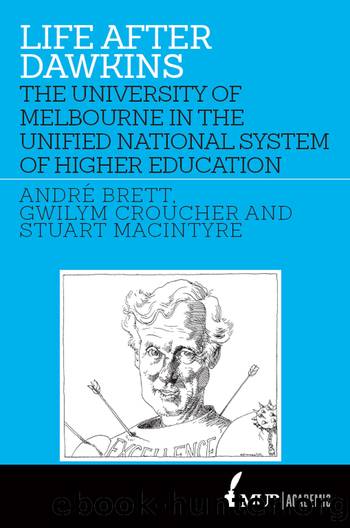Life after Dawkins by Macintyre Stuart;Croucher Gwilym;Brett André;

Author:Macintyre, Stuart;Croucher, Gwilym;Brett, André;
Language: eng
Format: epub
Publisher: Melbourne University Publishing
CHAPTER 8
Research
Universities like Melbourne entered the Unified National System with a substantial advantage. Unlike the college sector, they had been funded for research: the salaries component of their operating grant was based on the assumption that academics should have time for research as well as teaching, and the grant also included a component for research costs. This in turn enabled the universities to attract almost all of the competitive funds that were offered by the Australian Research Grants Committee (ARGC), while those with medical faculties benefited from the separate (and, in the 1980s, more substantial) scheme operated by the National Health and Medical Research Council (NHMRC).
Melbourneâs research effort in 1988 involved a direct expenditure of more than $39 million for an outlay of $9496 per student, above the sector average.1 These funds were drawn from a variety of sources, including the research component of the operational grant: $9.3 million in 1988. Following a trajectory established decades before, the laboratory disciplines attracted the largest share of support from the ARGC and NHMRC. Hence the Faculty of Medicine spent nearly $19 million on research in 1988, Science $6.9 million, Engineering $4.2 million and Veterinary Science $2.4 million. In addition, Melbourne received other research funds from a number of Commonwealth departments. These were supplemented by significant philanthropic support, again largely directed to medical research. The State Government provided only $768 000 in 1988, mainly to the science and health-based disciplines. There were also a number of the Commonwealth-funded Special Research Centres, such as in cancer, transplantation and cell biology, which reflected the strong biomedical research effort at the University.
A large part of the research income supported Research Only staff: $17 million in 1988. The University had 994 PhD students and another 1624 enrolled in Masters research degrees, supported by scholarship expenditure of $3.4 million. The majority of scholarships were in Medicine, Science, Engineering and Arts. The latterâs expenditure on PhD stipends made up a quarter of the Facultyâs total research expenditure in that year of $1.9 million.
Grants and contracts went to faculties as awarded. Part of the $9.3 million research component of the operational grant was allocated to faculties, part retained centrally for special research grants and large equipment purchases, and part for building the collection of the University Libraryâalthough some departments used their research allocation to maintain small, discipline-specific collections. Faculties and departments also drew on these allocations to employ research assistants, meet travel costs, purchase smaller items of equipmentâmany departments were adopting personal computers by 1988âand provide support for their higher-degree students.
The Green and White Papers were premised on the proposition that higher education should better serve the countryâs economic goals and that research should be directed to investigations that would lift productivity. For some time the governmentâs principal advisory body, the Australian Science and Technology Council (ASTEC) had been arguing for greater selectivity and its 1987 report, Improving the Research Performance of Australiaâs Universities and other Higher Education Institutions, led to the formation of a new funding body, the Australian Research Council (ARC), which was to exercise closer control over the research effort.
Download
This site does not store any files on its server. We only index and link to content provided by other sites. Please contact the content providers to delete copyright contents if any and email us, we'll remove relevant links or contents immediately.
The Art of Coaching Workbook by Elena Aguilar(50155)
Trainspotting by Irvine Welsh(21063)
Twilight of the Idols With the Antichrist and Ecce Homo by Friedrich Nietzsche(18314)
The Secret History by Donna Tartt(18253)
All the Missing Girls by Megan Miranda(14833)
Cat's cradle by Kurt Vonnegut(14800)
Ready Player One by Cline Ernest(14058)
Talking to Strangers by Malcolm Gladwell(12911)
Fangirl by Rainbow Rowell(8812)
The Compound Effect by Darren Hardy(8539)
Thirteen Reasons Why by Jay Asher(8485)
The remains of the day by Kazuo Ishiguro(8426)
Periodization Training for Sports by Tudor Bompa(7939)
Tools of Titans by Timothy Ferriss(7844)
Wonder by R. J. Palacio(7753)
The Lover by Duras Marguerite(7603)
Change Your Questions, Change Your Life by Marilee Adams(7397)
A Court of Wings and Ruin by Sarah J. Maas(7301)
The Complete Stick Figure Physics Tutorials by Allen Sarah(7159)
